英语语言学第二章
- 格式:pptx
- 大小:629.17 KB
- 文档页数:51
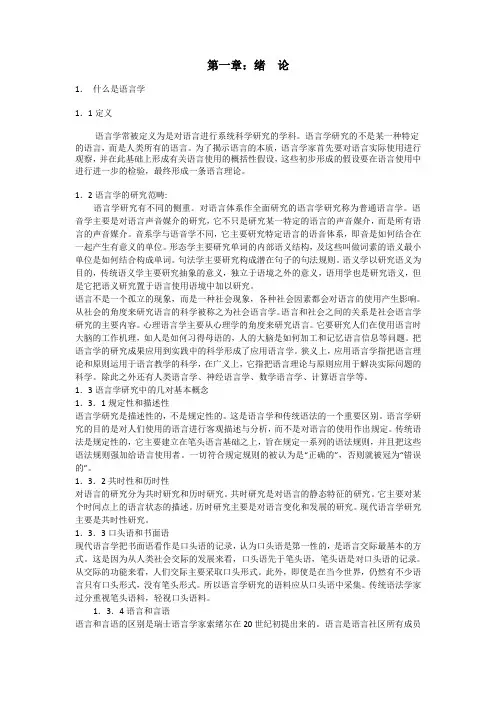
第一章:绪论1.什么是语言学1.1定义语言学常被定义为是对语言进行系统科学研究的学科。
语言学研究的不是某一种特定的语言,而是人类所有的语言。
为了揭示语言的本质,语言学家首先要对语言实际使用进行观察,并在此基础上形成有关语言使用的概括性假设,这些初步形成的假设要在语言使用中进行进一步的检验,最终形成一条语言理论。
1.2语言学的研究范畴:语言学研究有不同的侧重。
对语言体系作全面研究的语言学研究称为普通语言学。
语音学主要是对语言声音媒介的研究,它不只是研究某一特定的语言的声音媒介,而是所有语言的声音媒介。
音系学与语音学不同,它主要研究特定语言的语音体系,即音是如何结合在一起产生有意义的单位。
形态学主要研究单词的内部语义结构,及这些叫做词素的语义最小单位是如何结合构成单词。
句法学主要研究构成潜在句子的句法规则。
语义学以研究语义为目的,传统语义学主要研究抽象的意义,独立于语境之外的意义,语用学也是研究语义,但是它把语义研究置于语言使用语境中加以研究。
语言不是一个孤立的现象,而是一种社会现象,各种社会因素都会对语言的使用产生影响。
从社会的角度来研究语言的科学被称之为社会语言学。
语言和社会之间的关系是社会语言学研究的主要内容。
心理语言学主要从心理学的角度来研究语言。
它要研究人们在使用语言时大脑的工作机理,如人是如何习得母语的,人的大脑是如何加工和记忆语言信息等问题。
把语言学的研究成果应用到实践中的科学形成了应用语言学。
狭义上,应用语言学指把语言理论和原则运用于语言教学的科学,在广义上,它指把语言理论与原则应用于解决实际问题的科学。
除此之外还有人类语言学、神经语言学、数学语言学、计算语言学等。
1.3语言学研究中的几对基本概念1.3.1规定性和描述性语言学研究是描述性的,不是规定性的。
这是语言学和传统语法的一个重要区别。
语言学研究的目的是对人们使用的语言进行客观描述与分析,而不是对语言的使用作出规定。
传统语法是规定性的,它主要建立在笔头语言基础之上,旨在规定一系列的语法规则,并且把这些语法规则强加给语言使用者。
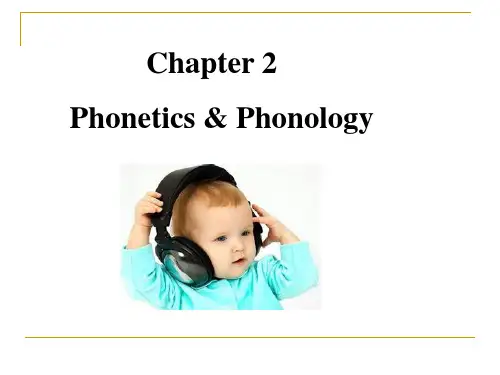
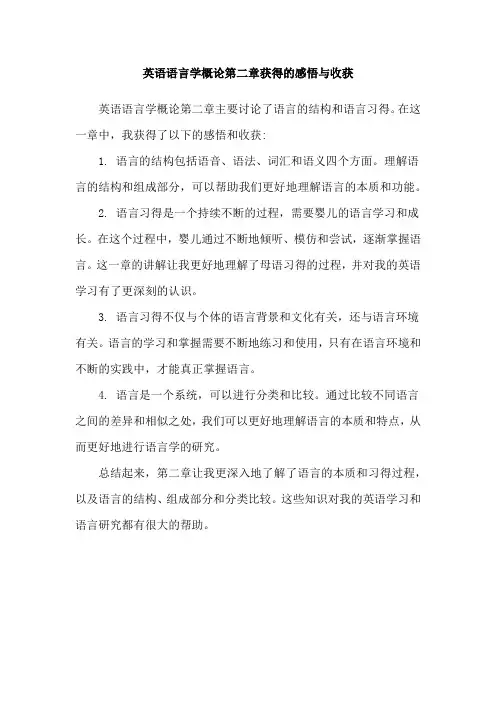
英语语言学概论第二章获得的感悟与收获
英语语言学概论第二章主要讨论了语言的结构和语言习得。
在这一章中,我获得了以下的感悟和收获:
1. 语言的结构包括语音、语法、词汇和语义四个方面。
理解语言的结构和组成部分,可以帮助我们更好地理解语言的本质和功能。
2. 语言习得是一个持续不断的过程,需要婴儿的语言学习和成长。
在这个过程中,婴儿通过不断地倾听、模仿和尝试,逐渐掌握语言。
这一章的讲解让我更好地理解了母语习得的过程,并对我的英语学习有了更深刻的认识。
3. 语言习得不仅与个体的语言背景和文化有关,还与语言环境有关。
语言的学习和掌握需要不断地练习和使用,只有在语言环境和不断的实践中,才能真正掌握语言。
4. 语言是一个系统,可以进行分类和比较。
通过比较不同语言之间的差异和相似之处,我们可以更好地理解语言的本质和特点,从而更好地进行语言学的研究。
总结起来,第二章让我更深入地了解了语言的本质和习得过程,以及语言的结构、组成部分和分类比较。
这些知识对我的英语学习和语言研究都有很大的帮助。


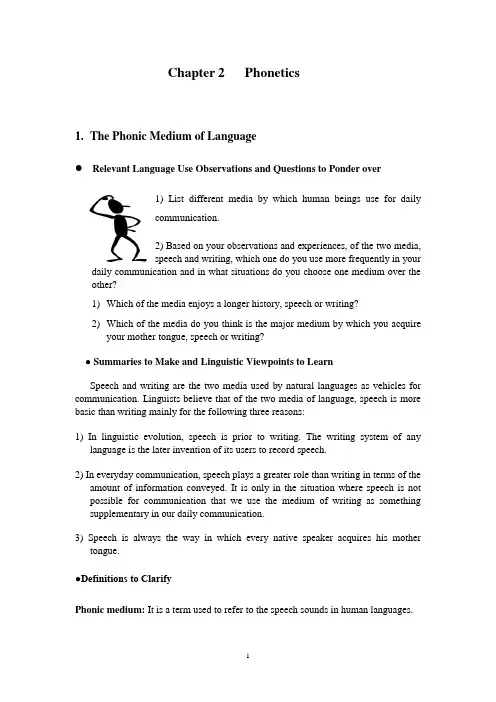
Chapter 2 Phonetics1.The Phonic Medium of LanguageRelevant Language Use Observations and Questions to Ponder over1) List different media by which human beings use for dailycommunication.2) Based on your observations and experiences, of the two media,speech and writing, which one do you use more frequently in your daily communication and in what situations do you choose one medium over the other?1)Which of the media enjoys a longer history, speech or writing?2)Which of the media do you think is the major medium by which you acquireyour mother tongue, speech or writing?● Summaries to Make and Linguistic Viewpoints to LearnSpeech and writing are the two media used by natural languages as vehicles for communication. Linguists believe that of the two media of language, speech is more basic than writing mainly for the following three reasons:1) In linguistic evolution, speech is prior to writing. The writing system of anylanguage is the later invention of its users to record speech.2) In everyday communication, speech plays a greater role than writing in terms of theamount of information conveyed. It is only in the situation where speech is not possible for communication that we use the medium of writing as something supplementary in our daily communication.3) Speech is always the way in which every native speaker acquires his mothertongue.●Definitions to ClarifyPhonic medium: It is a term used to refer to the speech sounds in human languages.2. Phonetics2.1 What is Phonetics?Relevant Language Use Observations and Questions to Ponder over1) When you communicate with others orally, a message is producedby our speech organs in the form of sounds, transmitted through acertain physical means and perceived by the hearer. What do you thinkare the basic contents involved in the study of speech sounds?2) Why should we study how humans produce speech sounds, how speech soundstravel in the air and how they are perceived by hearers?● Summaries to Make and Linguistic Viewpoints to LearnPhonetics studies speech sounds according to their production in the vocal organs (articulatory phonetics) from the speaker’s point of view, their physical properties (acoustic phonetics) from the way sounds travel and the physical means by which sounds are transmitted, or their effect on the ear (auditory phonetics) from the hearer’s point of view.Articulatory phonetics is general, descriptive and classificatory. It is general, because it studies all the speech sounds in all human languages. It is descriptive because it describes how speech sounds are produced. It is classificatory, because it involves the classification of speech sounds into different categories, such as consonants and vowels.Auditory phonetics focuses on the perception of sounds or the way in which sounds are heard and interpreted. We are in fact dealing with two distinct operations which, however, are closely interrelated and influence each other: on the one hand we can talk about audition proper, that is the perception of sounds by our auditory apparatus and the transforming of the information into a neural sign and its sending to the brain and, on the other hand, we can talk about the analysis of this information by the brain which eventually leads to the decoding of the message, the understanding of the verbal message.When discussing the auditory system we can consequently talk about its peripheral and its central part, respectively.Acoustic phonetics is a subfield of phonetics which deals with acoustic aspects of speech sounds. Acoustic phonetics investigates properties like the amplitude of a waveform, its duration, its fundamental frequency, or other properties of its frequency spectrum, and the relationship of these properties to other branches of phonetics (e.g. articulatory or auditory phonetics), and to abstract linguistic concepts like phones, phrases, or utterances.The study of acoustic phonetics was greatly enhanced in the late 19th century by the invention of the Edison phonograph. The phonograph allowed the speech signal to be recorded and then later processed and analyzed. By replaying the same speech signal from the phonograph several times, filtering it each time with a different band-pass filter, a spectrogram of the speech utterance could be built up.A thorough knowledge of how vowels and consonants are generated remains essential for successful assessment and remediation of articulatory and phonological disorders. Although contemporary phonological theories have provided new ways of viewing assessment and treatment of these disorders, knowledge of the speech sounds’ production features secures a firm basis for utilizing such procedures. Without this knowledge, phonological process analysis, for example, is impossible. A thorough knowledge of phonetics can help us understand how we perceive sounds so that we can efficiently interpret messages sent by others. Finally, the findings in the study of phonetics are widely used in person-machine communication, speech synthesis, speaker identification, voice prints analysis, voice identification and voice lineups, voice imitation and impersonation, speech recognition, speech production and perception disorders, correction of speech disorders, second language acquisition, etc..● Definitions to ClarifyPhonetics: Phonetics is defined as the study of the phonic medium of language; it studies speech sounds: the way in which they are produced (uttered, articulated), the way in which they are perceived, and their physical characteristics.Articulatory phonetics:Articulatory phonetics studies how speech sounds are produced, how they are categorized or classified.Auditory phonetics:Auditory phonetics focuses on the perception of sounds or the way in which sounds are heard and interpreted.Acoustic phonetics:It studies physical properties of speech sounds from the way sounds travel and the physical means by which speech sounds are transmitted.2.2 Organs of SpeechRelevant Language Use Observations and Questions to Ponder over1) What are the major organs of speech in our mouth which areinvolved in the production of speech sounds? Can you name some ofthese speech organs?2) When we close our mouth, letting air-stream coming out of ournoses, what sounds can be produced? Give some examples.3) Put your finger on your larynx and feel the effect when you produce each pair of sounds t/d, p/b and s/z, what result have you found?● Summaries to Make and Linguistic Viewpoints to LearnOur speech organs (the articulatory apparatus) are contained in three important areas or cavities: the oral cavity (mouth), the nasal cavity (nose) and the pharyngeal cavity (throat).2.2.1 The Oral CavityThe oral cavity is the area from the back of the throat to the mouth. The major parts of the oral cavity that are used in speech production are the uvula, the velum, the tongue, the hard palate, the alveolar ridge, the teeth, and the lips. The uvula is that fleshy blob that hangs down in the back of the throat. The velum is the soft palate, and the alveolar ridge is a mass of hard cartilage behind the teeth.The picture on the left shows thepositions of these major parts of theoral cavity. The oral cavity is one ofthe most important parts of the vocaltract. Its size, shape and acoustics canbe varied by the movements of thepalate, the tongue, the lips, and theteeth. Especially the tongue is veryflexible, the tip and the edges can bemoved independently and the entiretongue can move forward, backward,up and down. The lips control thesize and shape of the mouth openingthrough which speech sound isradiated.2.2.2 The Nasal CavityThe nasal cavity and oral cavity are connected with each other. Nasalized sounds are produced when we close our mouths so that the air coming from our lungs can only exit through our noses. If we allow the air to exit only through our months by drawing back the soft part of the roof of the mouth, the velum, the sounds produced are not nasalized.2.2.3 Pharyngeal CavityPharyngeal cavity(throat) consists of the area above the larynx and below the uvula. In the pharyngeal cavity, there are such speech organs as vocal cords. When speaking, the air flow is forced through the glottis between the vocal cords and the larynx to the three main cavities. The V-shaped opening between the vocal cords, called the glottis, is the most important sound source in the vocal system. The vocal cords may act in several different ways during speech. The most important function is to modulate the air flow by rapidly opening and closing, causing vibration from which vowels and voiced consonants are produced. With stop consonants the vocal cords may act suddenly from a completely closed position in which they cut the air flow completely, to totally open position producing a light cough or a glottal stop. On theother hand, with unvoiced consonants, such as /s/ or /f/, they may be completely open. An intermediate position may also occur with for example phonemes like /h/.● Definitions to ClarifyVoicing: Vibration of the vocal cords results in a quality of speech sounds called voicing.Voiceless sounds: When the vocal cords are drawn wide apart, letting air go through without causing vibration, the sounds produced in such a condition are voiceless , such as [t], [s], and [f] in English.Voiced sounds: The speech sounds produced with the vibration of the vocal cords are voiced sounds. All vowels and some consonants such as [b], [z], and [m] are voiced. 2.3 Classification of English Speech Sounds2.3.1 Classification of English ConsonantsRelevant Language Use Observations and Questions to Ponder over1) Observe how the air-stream is obstructed when thefollowing sounds are pronounced: Put your choice in the formof a tick in the following column:2) Work with your desk-mate to observe where the air-stream is obstructed when the following sounds are pronounced. Write your answers in the following table:● Summaries to Make and Linguistic Viewpoints to LearnEnglish consonants are usually classified by the manner of articulation and by the place of articulation. When we approach the classification of English consonants from the manner of articulation, we mainly look at how the air-stream is obstructed when we produce a consonant. When we group the consonants according to the place of articulation, we mainly look at where the air-stream is obstructed in the production of a consonant.According to the manner of articulation, English consonants are classified into plosives or stops: [p] [b] [t] [d]; fricatives: [f] [v] [s] [z] [ ; affricates: [t ] [d ]; nasals: [m] [n] [ ; liquids (laterals): [l] [r]; and semivowels (glides): [w] [j].By the place of articulation, English consonants can be classified into bilabials: [p] [b] [m] [w]; labiodentals: [f] [v]; dental: ; alveolars: [t] [d] [s] [z] [n] [l] [r]; palatals: [ [t ] [d ] [j]; velars: [k] [g] [ and glottal: [h].With these principles, we can describe the phonetic features of a consonant and see how a consonant is produced. For example:[t]: voiceless, alveolar, plosive[d]: voiced, alveolar, plosive[t voiceless, palatal, affricate[d voiced, palatal, affricateSome of the other consonants are described as follows:● Definitions to ClarifyConsonants: The consonants are the speech sounds in the production of which the air coming from the lungs is obstructed in one way or another.Plosives (stops): They are the consonants in the production of which the obstruction to the air-stream is complete and the suddenly released with an audible sound.Fricatives: They are the consonants in the production of which the obstruction to the air-stream is incomplete and the air-stream is forced to come out of a narrow passage with friction.Affricates: They are the consonants in the production of which the obstruction to the air-stream is complete and then it is slowly released with friction.Nasals: Thy are the consonants in the production of which the soft palate is lowered, allowing the air-stream to pass through the nasal passage.Liquids (laterals): They are the consonants in the production of which the air-stream is obstructed, but allowed to pass between the tip or the sides of the tongue and the roof of the mouth.Semivowels (glides): They are the consonants in the production of which the obstruction is such that the air-stream comes out of a narrower passage between the lips or between the tongue and the hard palate.Bilabial: They are the consonants in the production of which the obstruction is formed by the upper and the lower lips.Labiodental: They are the consonants in the production of which the obstruction is created by the upper teeth and lower lip.Dental: the consonants in the production of which the obstruction is created by the tip of the tongue and the upper teeth.Alveolar: They are the consonants in the production of which the obstruction is made between the tip of the tongue and the upper teeth-ridge.Palatal: They are the consonants in the production of which the obstruction is formed between the back of the tongue and the hard palate.Velar: They are the consonants in the production of which the obstruction is created between the back of the tongue and the soft palate.Glottal: They are the consonant in the production of which the obstruction is momentarily made by the bringing together of the vocal cords.2.3.2 Classification of English VowelsRelevant Language Use Observations and Questions to Ponder over1)Compare the following vowels in Column A with Vowelsin Column B to find their differences:2)Work with your desk-mate to observe the shape of the lips when you pronounce the following sounds and note down in the diagram which vowels are rounded and which ones are unrounded:3) Observe the openness of the mouth when you pronounce the following vowels.● Summaries to Make and Linguistic Viewpoints to LearnVowel sounds are classified according to the length of the vowels, and the openness of the mouth, the shape of the lips, and the position of the tongue which is raised the highest.According to the length of the vowels, English vowels are of the two groups: long vowels such as [i:] [ :] [ : ] [u:] [ɑ:]and short vowels[i] [e] [ ] [ ] [ ] [u], etc. According to the openness of the mouth, English vowels are divided into four subcategories:(1) close vowels: [i:] [i] [u:] and [u](2) semi-close vowels: [e] and [ :](3) semi-open vowels: [ ] and [ : ](4) open vowels: [ ] [ ] [ ] [ ] and [ : ].According to the shape of the lips, English vowels are grouped into rounded vowels and unrounded vowels: All the back vowels in English are rounded except [ɑ:]. All the front vowels and central vowels in English are unrounded.According to the position of the tongue in the mouth that is raised the highest, English vowels are classified into front vowels, central vowels and back vowels: Front vowels are the ones in the production of which the front part of the tongue is raised the highest such as [i:] [i] [e] [ ] [ ]; When the central part of the tongue maintains its highest position, the vowels thus produced are central vowels suchas [ :] [ ] and [ ]; if the back of the tongue is held the highest, the vowels thus produced are back vowels such as [u:] [u] [[ :] [ ] and [ :].With these criteria, we can describe the phonetic features of English vowels, for example:[e]: short, front, semi-close, unrounded[i:]: long, front, close, unrounded[ ]: short, front, open, unrounded[● Definitions to ClarifyVowels: Vowels are the speech sounds in the pronunciation of which, the air that comes from the lungs meets with no obstruction of any kind in the throat, the nose, or the mouth.Exercises1.Define the following terms:Phonic medium; articulatory phonetics; phonetics; vowels; consonants; voicing 2.How is articulatory phonetics different from acoustic phonetics and auditoryphonetics?3.How do we classify vowels?4.How do we classify consonants?5.Write out the phonetic features of the following consonants and vowels:/t//p//m//z//u//i//æ/[ ]6.Give the phonetic symbol for each of the following sound descriptions:voiced bilabial stopvoiceless alveolar fricativevoiced velar stopvoiceless palatal affricateshort front open unroundedFurther ReadingsJackson, Howard. Analyzing English: an introduction to descriptive linguistics. New York: Pergamon Press Ltd. 1982.孟宪忠(编著).英语语音学(第三版).上海:华东师范大学出版社.2006.张凤桐.英国英语语音学和音系学(第3版).成都:四川大学出版社.2002.罗奇(英).英语语音学与音系学使用教程. 北京: 外语教学与研究出版社. 2000.。
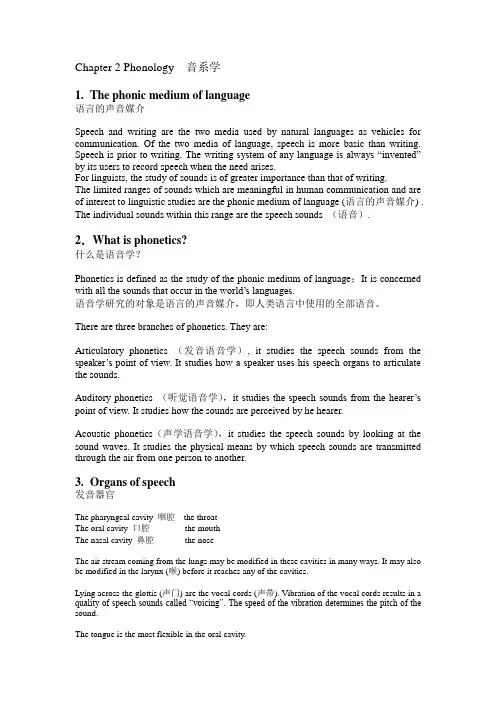
Chapter 2 Phonology 音系学1.The phonic medium of language语言的声音媒介Speech and writing are the two media used by natural languages as vehicles for communication. Of the two media of language, speech is more basic than writing. Speech is prior to writing. The writing system of any language is always “invented” by its users to record speech when the need arises.For linguists, the study of sounds is of greater importance than that of writing.The limited ranges of sounds which are meaningful in human communication and are of interest to linguistic studies are the phonic medium of language (语言的声音媒介) . The individual sounds within this range are the speech sounds (语音). 2.What is phonetics?什么是语音学?Phonetics is defined as the study of the phonic medium of language;It is concerned with all the sounds that occur in the world’s languages.语音学研究的对象是语言的声音媒介,即人类语言中使用的全部语音。
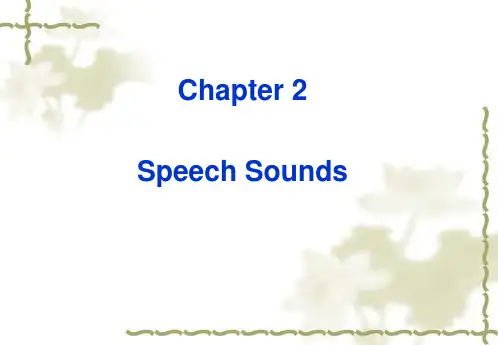
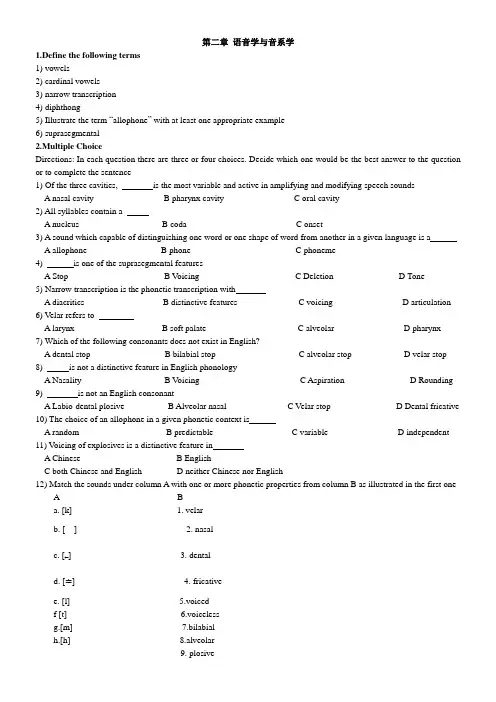
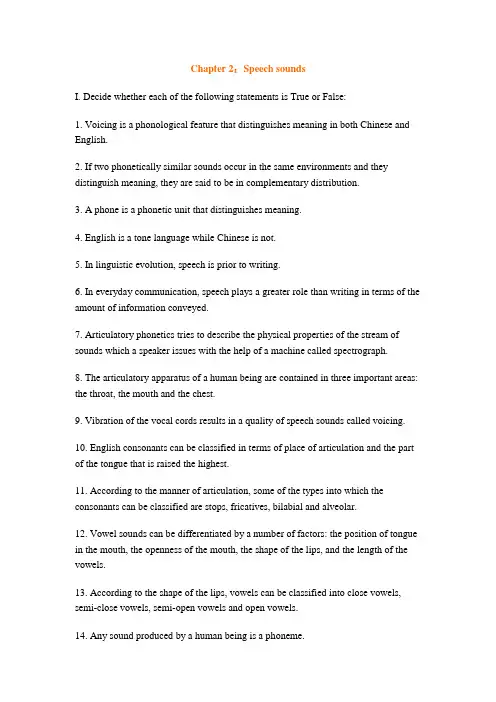
Chapter 2:Speech soundsI. Decide whether each of the following statements is True or False:1. Voicing is a phonological feature that distinguishes meaning in both Chinese and English.2. If two phonetically similar sounds occur in the same environments and they distinguish meaning, they are said to be in complementary distribution.3. A phone is a phonetic unit that distinguishes meaning.4. English is a tone language while Chinese is not.5. In linguistic evolution, speech is prior to writing.6. In everyday communication, speech plays a greater role than writing in terms of the amount of information conveyed.7. Articulatory phonetics tries to describe the physical properties of the stream of sounds which a speaker issues with the help of a machine called spectrograph.8. The articulatory apparatus of a human being are contained in three important areas: the throat, the mouth and the chest.9. Vibration of the vocal cords results in a quality of speech sounds called voicing.10. English consonants can be classified in terms of place of articulation and the part of the tongue that is raised the highest.11. According to the manner of articulation, some of the types into which the consonants can be classified are stops, fricatives, bilabial and alveolar.12. Vowel sounds can be differentiated by a number of factors: the position of tongue in the mouth, the openness of the mouth, the shape of the lips, and the length of the vowels.13. According to the shape of the lips, vowels can be classified into close vowels, semi-close vowels, semi-open vowels and open vowels.14. Any sound produced by a human being is a phoneme.15. Phones are the sounds that can distinguish meaning.16. Phonology is concerned with how the sounds can be classified into different categories.17. A basic way to determine the phonemes of a language is to see if substituting one sound for another results in a change of meaning.18. When two different forms are identical in every way except for one sound segment which occurs in the same place in the strings, the two words are said to form a phonemic contrast.19. The rules governing the phonological patterning are language specific.20. The transcription of speech sounds with letter-symbols only is called broad transcription while the transcription with letter-symbols together with the diacritics is called narrow transcription.II. Fill in each of the following blanks with one word which begins with the letter given:21.The distinction between vowels and consonants lies in the obstruction ofa______.22.A___________ phonetics describes the way our speech organs work to produce the speech sounds and how they differ.23.The four sounds /p/,/b/,/m/ and /w/ have one feature in common, i.e, they are all b_______ sounds.24.Of all the speech organs, the t ____ is the most flexible, and is responsible for varieties of articulation than any other.25.English consonants can be classified in terms of manner of articulation or in terms of p_______ of articulation.26.When the obstruction created by the speech organs is total or complete, the speech sound produced with the obstruction audibly released and the air passing out again is called a s________.27.S_________ features are the phonemic features that occur above the level of the segments. They include stress, tone, intonation, etc.28.P______ is the smallest linguistic unit of sound that can signal a difference in meaning.29.The transcription of speech sounds with letter-symbols only is called broad transcription while the transcription with letter-symbols together with the diacritics is called n_________ transcription.30.When pitch, stress and sound length are tied to the sentence rather than the word in isolation, they are collectively known as i_________.31.P___________ is a discipline which studies the system of sounds of a particular language and how sounds are combined into meaningful units to effect linguistic communication.32.The articulatory apparatus of a human being are contained in three important cavities: the pharyngeal cavity, the o_______ cavity and the nasal cavity.33.The sounds produced with the vocal cords vibrating are v ____ sounds.34.Depending on the context in which stress is considered, there are two kinds of stress: word stress and s_________ stress.III. There are four choices following each of the statements below. Mark the choice that can best complete the statement:35.Of all the speech organs, the _______ is/ are the most flexible.A. mouthB. lipsC. tongueD. vocal cords36.The sounds produced without the vocal cords vibrating are ____ sounds.A. voicelessB. voicedC. vowelD. consonantal37.__________ is a voiced alveolar stop.A. /z/B. /d/C. /k/D./b/38.The assimilation rule assimilates one sound to another by “copying” a feature of a sequential phoneme, thus making the two phones ____________.A. identicalB. sameC. exactly alikeD. similar39.Since /p/ and /b/ are phonetically similar, occur in the same environments and they can distinguish meaning, they are said to be ___________.A. in phonemic contrastB. in complementary distributionC. the allophonesD. minimal pair40.The sound /f/ is _________________.A. voiced palatal affricateB. voiced alveolar stopC. voiceless velar fricativeD. voiceless labiodental fricative41. A ____ vowel is one that is produced with the front part of the tongue maintaining the highest position.A. backB. centralC. frontD. middle42. Distinctive features can be found running over a sequence of two or more phonemic segments. The phonemic features that occur above the level of the segments are called ____________.A. phonetic componentsB. immediate constituentsC. suprasegmental featuresD. semantic features43. A(n) ___________ is a unit that is of distinctive value. It is an abstract unit, a collection of distinctive phonetic features.A. phoneB. soundC. allophoneD. phoneme44.The different phones which can represent a phoneme in different phonetic environments are called the ____ of that phoneme.A. phonesB. soundsC. phonemesD. allophonesIV. Define the terms below:45. phonology 46. phoneme 47.allophone 48. minimal pair49. intonation 50. phoneticsV. Answer the following questions as comprehensively as possible. Give examples for illustration if necessary:51. Of the two media of language, why do you think speech is more basic than writing ?52. What are the criteria that a linguist uses in classifying consonants ?53. What are the major differences between phonology and phonetics ?54. Illustrate with examples how suprasegmental features can affect meaning.。
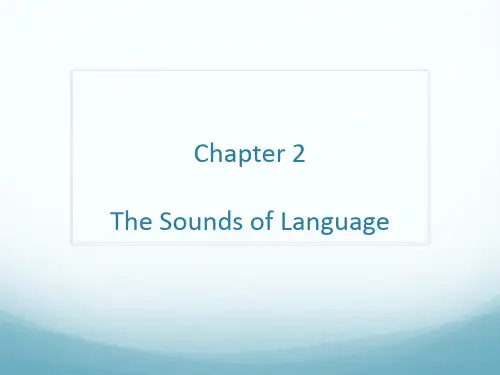
Chapter 2 Phonology 音系学1. The phonic medium of language语言的声音媒介Speech and writing are the two media used by natural languages as vehicles for communication. Of the two media of language, speech is more basic than writing. Speech is prior to writing. The writing system of any language is always “invented” by its users to record speech when the need arises.For linguists, the study of sounds is of greater importance than that of writing.The limited ranges of sounds which are meaningful in human communication and are of interest to linguistic studies are the phonic medium of language (语言的声音媒介) . The individual sounds within this range are the speech sounds (语音). 2.What is phonetics?什么是语音学?Phonetics is defined as the study of the phonic medium of language;It is concerned with all the sounds that occur in the world’s languages.语音学研究的对象是语言的声音媒介,即人类语言中使用的全部语音。
Chapter 2 Speech Sounds2.1 Speech production and perceptionPhonetics is the study of speech sounds. It includes three main areas:1. Articulatory phonetics – the study of the production of speech sounds2. Acoustic phonetics –the study of the physical properties of the sounds produced inspeech3. Auditory phonetics – the study of perception of speech soundsMost phoneticians are interested in articulatory phonetics.2.2 Speech organsSpeech organs are those parts of the human body involved in the production of speech. The speech organs can be considered as consisting of three parts: the initiator of the air stream, the producer of voice and the resonating cavities.2.3 Segments, divergences, and phonetic transcription2.3.1 Segments and divergencesAs there are more sounds in English than its letters, each letter must represent more than one sound.2.3.2 Phonetic transcriptionInternational Phonetic Alphabet (IPA): the system of symbols for representing the pronunciation of words in any language according to the principles of the InternationalPhonetic Association. The symbols consists of letters and diacritics. Some letters aretaken from the Roman alphabet, some are special symbols.2.4 Consonants2.4.1 Consonants and vowelsA consonant is produced by constricting or obstructing the vocal tract at someplaces to divert, impede, or completely shut off the flow of air in the oral cavity.A vowel is produced without obstruction so no turbulence or a total stopping of theair can be perceived.2.4.2 ConsonantsThe categories of consonant are established on the basis of several factors. The most important of these factors are:1. the actual relationship between the articulators and thus the way in which theair passes through certain parts of the vocal tract (manner of articulation);2. where in the vocal tract there is approximation, narrowing, or the obstructionof the air (place of articulation).2.4.3 Manners of articulation1. Stop/plosive: A speech sound which is produced by stopping the air streamfrom the lungs and then suddenly releasing it. In English,[☐ ♌ ♦ ♎ ♑] are stops and [❍ ⏹ ☠]are nasal stops.2. Fricative: A speech sound which is produced by allowing the air stream fromthe lungs to escape with friction. This is caused by bringing the twoarticulators, e.g. the upper teeth and the lower lip, close together but notcloses enough to stop the airstreams completely. In English,[♐ ❆ ♦ ☞ ✞ ♒] are fricatives.3. (Median) approximant: An articulation in which one articulator is close toanother, but without the vocal tract being narrowed to such an extent that aturbulent airstream is produced. In English this class of sounds includes[♦ ❑ ].4. Lateral (approximant): A speech sound which is produced by partiallyblocking the airstream from the lungs, usually by the tongue, but letting itescape at one or both sides of the blockage. [●] is the only lateral in English.Other consonantal articulations include trill, tap or flap, and affricate.2.4.4 Places of articulation1. Bilabial: A speech sound which is made with the two lips.2. Labiodental: A speech sound which is made with the lower lip and the upperfront teeth.3. Dental: A speech sound which is made by the tongue tip or blade and theupper front teeth.4. Alveolar: A speech sound which is made with the tongue tip or blade and thealveolar ridge.5. Postalveolar: A speech sound which is made with the tongue tip and the backof the alveolar ridge.6. Retroflex: A speech sound which is made with the tongue tip or blade curledback so that the underside of the tongue tip or blade forms a stricture with theback of the alveolar ridge or the hard palate.7. Palatal: A speech sound which is made with the front of the tongue and thehard palate.8. Velar: A speech sound which is made with the back of the tongue and the softpalate.9. Uvular: A speech sound which is made with the back of the tongue and theuvula, the short projection of the soft tissue and muscle at the posterior end ofthe velum.10. Pharyngeal: A speech sound which is made with the root of the tongue and thewalls of the pharynx.11. Glottal: A speech sound which is made with the two pieces of vocal foldspushed towards each other.2.4.5 The consonants of EnglishReceived Pronunciation (RP): The type of British Standard English pronunciation which has been regarded as the prestige variety and which shows no regional variation. It has often been popularly referred to as “BBC English” or “Oxford English” because it is widely used in the private sector of the education system and spoken by most newsreaders of the BBC network.articulation. These pairs of consonants are distinguished by voicing, the one appearingon the left is voiceless and the one on the right is voiced.Therefore, the consonants of English can be described in the following way:[p] voiceless bilabial stop[b] voiced bilabial stop[s] voiceless alveolar fricative[z] voiced alveolar fricative[m] bilabial nasal[n] alveolar nasal[l] alveolar lateral[j] palatal approximant[h] glottal fricative[r] alveolar approximant2.5 Vowels2.5.1 The criteria of vowel description1. The part of the tongue that is raised – front, center, or back.2. The extent to which the tongue rises in the direction of the palate. Normally,three or four degrees are recognized: high, mid (often divided into mid-highand mid-low) and low.3. The kind of opening made at the lips –various degrees of lip rounding orspreading.4. The position of the soft palate –raised for oral vowels, and lowered forvowels which have been nasalized.2.5.2 The theory of cardinal vowels[Icywarmtea doesn’t quite understand this theory.]Cardinal vowels are a set of vowel qualities arbitrarily defined, fixed and unchanging, intending to provide a frame of reference for the description of the actualvowels of existing languages.By convention, the eight primary cardinal vowels are numbered from one to eight as follows: CV1[♓], CV2[♏], CV3[☪], CV4[♋], CV5[ ], CV6[ ], CV7[☐],CV8[◆].A set of secondary cardinal vowels is obtained by reversing the lip-rounding for agive position: CV9 – CV16. [I am sorry I cannot type out many of these. If you want toknow, you may consult the textbook p. 47. – icywarmtea]2.5.3 Vowel glidesPure (monophthong) vowels: vowels which are produced without any noticeable change in vowel quality.V owel glides: V owels where there is an audible change of quality.Diphthong: A vowel which is usually considered as one distinctive vowel of a particular language but really involves two vowels, with one vowel gliding to the other.2.5.4 The vowels of RP[♓] high front tense unrounded vowel[◆] high back lax rounded vowel[☜] central lax unrounded vowel[ ] low back lax rounded vowel2.6 Coarticulation and phonetic transcription2.6.1 CoarticulationCoarticulation: The simultaneous or overlapping articulation of two successive phonological units.Anticipatory coarticulation: If the sound becomes more like the following sound, as in the case of lamp, it is known as anticipatory coarticulation.Perseverative coarticulation: If the sound displays the influence of the preceding sound, as in the case of map, it is perseverative coarticulation.Nasalization: Change or process by which vowels or consonants become nasal.Diacritics: Any mark in writing additional to a letter or other basic elements.2.6.2 Broad and narrow transcriptionsThe use of a simple set of symbols in our transcription is called a broad transcription. The use of more specific symbols to show more phonetic detail is referredto as a narrow transcription. The former was meant to indicate only these soundscapable of distinguishing one word from another in a given language while the latterwas meant to symbolize all the possible speech sounds, including even the minutestshades of pronunciation.2.7 Phonological analysisPhonetics is the study of speech sounds. It includes three main areas: articulatory phonetics, acoustic phonetics, and auditory phonetics. On the other hand, phonology studies the rules governing the structure, distribution, and sequencing of speech sounds and the shape of syllables.There is a fair degree of overlap in what concerns the two subjects, so sometimes it is hard to draw the boundary between them. Phonetics is the study of all possible speech sounds while phonology studies the way in which speakers of a language systematically use a selection of these sounds in order to express meaning. That is to say, phonology is concerned with the linguistic patterning of sounds in human languages, with its primary aim being to discover the principles that govern the way sounds are organized in languages, and to explain the variations that occur. 2.8 Phonemes and allophones2.8.1 Minimal pairsMinimal pairs are two words in a language which differ from each other by only one distinctive sound and which also differ in meaning. E.g. the English words tie anddie are minimal pairs as they differ in meaning and in their initial phonemes /t/ and /d/.By identifying the minimal pairs of a language, a phonologist can find out which soundsubstitutions cause differences of meaning.2.8.2 The phoneme theory2.8.3 AllophonesA phoneme is the smallest linguistic unit of sound that can signal a difference inmeaning. Any of the different forms of a phoneme is called its allophones. E.g. inEnglish, when the phoneme /☐/ occurs at the beginning of the word like peak/☐♓/, it is said with a little puff of air, it is aspirated. But when /☐/ occurs in theword like speak /♦☐♓/, it is said without the puff of the air, it is unaspirated. Boththe aspirated [☐♒] in peak and the unaspirated [☐=] in speak have the same phonemicfunction, i.e. they are both heard and identified as /☐/ and not as /♌/; they are bothallophones of the phoneme /☐/.2.9 Phonological processes2.9.1 AssimilationAssimilation: A process by which one sound takes on some or all the characteristics of a neighboring sound.Regressive assimilation: If a following sound is influencing a preceding sound, we call it regressive assimilation.Progressive assimilation: If a preceding sound is influencing a following sound, we call it progressive assimilation.Devoicing: A process by which voiced sounds become voiceless. Devoicing of voiced consonants often occurs in English when they are at the end of a word.2.9.2 Phonological processes and phonological rulesThe changes in assimilation, nasalization, dentalization, and velarization are all phonological processes in which a target or affected segment undergoes a structuralchange in certain environments or contexts. In each process the change is conditioned ortriggered by a following sound or, in the case of progressive assimilation, a precedingsound. Consequently, we can say that any phonological process must have three aspectsto it: a set of sounds to undergo the process; a set of sounds produced by the process; aset of situations in which the process applies.We can represent the process by mans of an arrow: voiced fricative →voiceless / __________ voiceless. This is a phonological rule. The slash (/) specifies theenvironment in which the change takes place. The bar (called the focus bar) indicatesthe position of the target segment. So the rule reads: a voiced fricative is transformedinto the corresponding voiceless sound when it appears before a voiceless sound.2.9.3 Rule ordering[No much to say, so omitted – icywarmtea]2.10 Distinctive featuresDistinctive feature: A particular characteristic which distinguishes one distinctive sound unit of a language from another or one group of sounds from another group.Binary feature: A property of a phoneme or a word which can be used to describe the phoneme or word. A binary feature is either present or absent. Binary features are also used to describe the semantic properties of words.2.11 SyllablesSuprasegmental features: Suprasegmental features are those aspects of speech that involve more than single sound segments. The principal suprasegmental features are syllables, stress, tone, and intonation.Syllable: A unit in speech which is often longer than one sound and smaller than a whole word.Open syllable: A syllable which ends in a vowel.Closed syllable: A syllable which ends in a consonant.Maximal onset principle: The principle which states that when there is a choice as to where to place a consonant, it is put into the onset rather than the coda. E.g. The correct syllabification of the word country should be / ✈⏹♦❑♓/. It shouldn’t be / ✈⏹♦❑♓/ or / ✈⏹♦❑♓/ according to this principle.2.12 StressStress refers to the degree of force used in producing a syllable. In transcription, a raised vertical line [ ] is used just before the syllable it relates to.。
英语语言学笔记第二章言语产生和言语感知人类可以发出各种声音,但只有其中一部分成为语言系统的单位。
正如我们从前面对语言的讨论中所看到的,语言首先是一个"语音符号系统",语音远远早于文字而存在,并且,即使是今天,在世界的某些角落,还有些语言是没有文字系统的。
因此,语音的研究是语言学的一个主要组成部分。
在这一章中,我们将考察语音研究的方法以及使用的模式。
我们将从语音研究,即"语音学"开始,然后进入语音模式,即"音系学"的研究。
可以想象,语音被说话者A发出,然后,它被传递并被说话者B接收,语音如图2.1所示经历了3个阶段。
言语产生言语感知(说话者A)→(说话者B)图2.1 言语产生和言语感知过程语音研究自然地分成三个主要领域,一个领域就是一个步骤。
●发音语音学研究语音的产生。
●声学语音学研究语音的物理特征。
●听觉语音学和语音感知有关。
在本书中,我们只集中讨论发音语音学,不涉及其他的研究领域。
语言学教程2.2 言语器官言语器官,如图2.2所示,也经常被称作发音器官。
它们是人体中参与制造言语的部分。
这些器官,并非仅仅用在言语中,它们的主要功能其实是满足呼吸和进食等基本生理需要。
虽然如此,这些器官看起来是经历了长期的进化以适应言语的各种特定的需要。
因为它们的形成保证了其能有效地在言语行为中发挥作用。
如果去考察人体有多少部分参与了言语行为,你会大吃一惊,它们是:肺,气管,喉,鼻和口。
在口里,我们需要辨别舌及腭的不同部分。
在喉里,我们还要辨别咽(喉的上部)和喉头(喉的下部,包括声带)。
咽、口和鼻组成了声道的三大腔,口和鼻常被分别称为口腔和鼻腔。
图2.2 言语器官(略)发音以气流作为其能量来源。
大多数情况下,气流来自于肺部,它从肺里被挤出,然后通过细支气管和支气管(通往气管的一些管道分支)。
以这种方式产生的语音叫做"肺闭塞音"。
气管的顶端是喉头,喉头的前端是喉结。